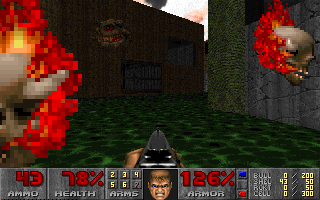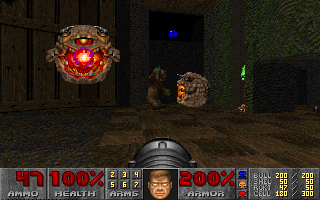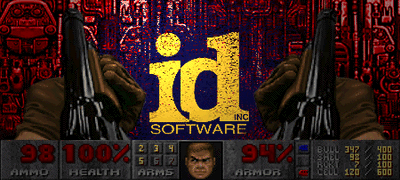Overview
From a living room in Shreveport, Louisianna to nearly every computer screen in the world, the makers of the Doom and Quake computer games explain their wild growth.
The World of id

It’s late at night. You flick off the light of your desk lamp, turn the computer off, grab your coat and head for the parking lot. You’re one of the last people to leave the office for the evening and you’re glad you can finally leave the day’s toils behind. As you stroll down the corridor towards the exit you notice a light on in an office down the hallway. As you approach the office with the eerie glow emanating from the door strange sounds begin to become audible. Grunts, groans and snarls become louder and louder with each step closer to the door you take. You hear heavy breathing as if someone was in extreme anguish. Then the explosions start and spine chilling screams followed by gruesome laughter. “What nightmare could be happening in that office?!,” you think as you reluctantly turn the corner to peer into the doorway. As the beads of sweat roll down your face and you slowly poke one eye into the open door an earth shattering scream lets out sending you reeling back against the wall, “YES! THE PLASMA RIFLE! NOW YOU’RE ALL GONNA DIE!!!”
Don’t be surprised if this situation sounds familiar to you. There is probably not a computer left on the planet be it in the home, office, or university that has not at one point in time or another had a copy of DOOM installed on it. DOOM is the award winning, world renowned 3-D shooter computer game that holds the amazing title of being the most installed computer software program ever! DOOM takes the game player and transports them into a macabre world of futuristic mutant humans and heavily armed aliens, and gives the user more firepower than what was used in the Gulf War to rid the Earth and any neighboring societies of this vermin by plain and simple brute force and attrition. What makes this game so different from other computer games in the past is that the creators of DOOM, id Software, pioneered the game play interface they call “first-person, texture map style game” which has become the de facto standard for all the games in this growing genre. This style of game offers the interface where the player is looking out through the eyes of their superhuman fighter into a 3-D rendered world with such realism and depth that the user feels they are directly inside the game. Enemies, scenery, and incoming salvos all have the look and depth of a realistic 3-D environment, and the user has complete control to move around, duck, jump, open doors and function as if they wearing the combat boots and shouldering a rifle themselves.
Located in Mesquite, Texas, id Software has created a family of computer game titles based on this style of play, and their perfection of this type of computing technology has made them the undisputed leader of the 3-D shooter style game. From the craters of Mars, to the castles of World War II Germany, to the mystical lands of sorcerers and witchcraft id has helped create some of the most popular computer games ever based on their innovations with the first-person, texture map style. Complementing this computer game development success was their marketing prowess to employ the internet and vast networks of computer bulletin boards and user groups to give part of their games away for free to establish their customer base. The “try before you by” technique proved to be phenomenally successful for id as they distributed a limited version of their software to the public for free to get the addictions established all over the world. They then offered the full versions to the public by charging a full game price. This strategy resulted in millions of copies of the id Software games being distributed all over the world, and healthy revenues for the now 14 person company totaling $16 MM dollars in 1995. DOOM has also been ported to many other popular game platforms including Sega, Super Nintendo and the Sony Playstation.
The EM spoke with Jay Wilbur who is the “Biz guy” for id Software and was one of id’s core members when the company was founded. Jay discussed the beginnings of the company, what it was like when they were working out of his living room in their original Louisiana location, the phenomenal growth of the company, the partnerships they have developed to nurture their growth, competitors and copy-cat games, and the technology and game play innovation that stems largely from their own preferences as computer gamers. Jay also discussed the future of id including their next software title release called “Quake”, and the upcoming DOOM movie and book projects which truly show that DOOM and its cousins have transcended the hard disk drive into a cultural phenomenon.
Shreveport and Softdisk
The biggest attribute to id’s success and the success of their style of game according to Jay is the creative genius behind the technical wizards who invented the first-person texture mapping interface. The three persons who were the founders of id are John Carmack, John Romero, and Adrian Carmack. These three game developers all share in the birth of the id family of games and all have their own specialties in the development process that culminated to the products they offer. John Carmack is the id lead technologist and lead technical guru, John Romero is the chief level designer and game designer, and Adrian Carmack leads the artists in the art group. They are still with id and still very active in all aspects of the company’s product development.
These three coalesced in Shreveport, Louisiana while they were working for a software company called Softdisk. The primary project they were working on was a computer magazine on disk called “Gamer’s Edge”. This product was released with a new version every thirty days and within the publication was a new computer game. It was here that Jay says the group gelled to hone their skills in developing games together, and where the inklings of what they might be able to do on their own started to form. Jay worked for Softdisk as well, but was associated with John Romero well before all of the group’s association at Softdisk. It was during their tenure at Softdisk that the origins of their 3-D shooter started. According to Jay, John Carmack had conceived the technology for the first-person, texture map style game in an earlier game called Hovertank One. This concept is what the other founders of id built upon with their capabilities to ultimately come up with an earlier iteration of what exists today. “Everyone had play at the concept but it all came together as a result of John Carmack’s technology work. He would say, ‘I have an engine that does A, B, C…’ and one of those capabilities was texture mapping. The game was then built off of that.”

While the soon to be id Software Company was still working at Softdisk, an event took place that Jay says was a critical catalyst for id’s beginnings. A member of a Texas software development and distribution company called Apogee contacted John Romero to offer him an opportunity to create his own product, “Apogee contacted John Romero and said, ‘Make a game and I will distribute it,’ and Apogee offered a few thousand dollars in initial funds to show their good faith. It was that seed money that grew into Commander Keen.” Commander Keen was the first software offering from id, and of the genre of the 3-D shooter. One month after Commander Keen was released into shareware (the distribution technique of “try before you buy”) John Carmack, Adrian Carmack and John Romero left their jobs at Softdisk and officially begin id Software on February 1, 1991. At the early operations Jay was the unofficial biz guy doing everything he does for id now, but on a much smaller scale. “At that time is was just counting the beans and making sure they were all in the right place. Now I ride shotgun over distribution, fulfillment, all the business management aspects, and all the new opportunity assessments.”
id in the Living Room
The primary driver that Jay cites for id breaking off onto its own was independence. The group realized they had the capability of creating their own products, and they had the success of their first offering in the shareware marketplace. To proceed on their own appears to have been the next logical step. Like many new start-ups, resources and work locations are not always the primary concerns for the business’ operations. The id group had moved out of Softdisk and into the living room of Jay and John Romero’s home to create their workspace for the software development. “id started in the room right next to my bedroom,” Jay explained, “The early operations were simple as everyone had their computers laid out all over the place. It was a big room with a lot of people working in concert towards the end goal. In the beginning was the Commander Keen series and everyone knew what the project was and was working feverishly to get it out.”

As for funding and resources in the operations of id, the traditional outlets of friends, family and associates, or savings did not come into play, “We were all working in the computer industry at the time and everyone had a PC of their own. Just pick ’em all up and move them into the same room and you’re a start up.” As Jay described the operations in the early stages, he commented on the roles that everyone plays and the understanding of how each person desired to work, and how that vision still persists today, “The founders were the ones that wanted to drive the creative side of the product development and my work complemented the management and business side. In this situation the business side supports the creative side and the business side takes its cues from the creative side. When they (the creative side) spit out a game we (the business side) take it and run with it.” When reflecting on his role with the company, Jay commented on the level of intensity his role entails, “It tends to be busy on the business side of things because they are only two people running the business side of this $16 MM dollar company. There’s twelve guys in there and they pop out a game and we pick it up and haul butt with it.”
When it came to the development of the content of the game and the testing of the game for playability and user preference, most of this was done with their own opinions and preferences. Sometimes outside parties would come in, not on a formal level, mostly family and friends who id would show what they were doing for the project they were working on to get their opinions. But these software developers relied mostly on what they wanted in a game to drive their efforts, “Ultimately we market to ourselves. We slide right into the demographic mold of the people that we are trying to sell to.” This could be viewed as a risky proposition by not examining to great lengths the desires and preferences of your target market. However, you can’t argue with the fact that the interpretation of their profiles fitting their market demographics as being sound logic to determine what users will want.

